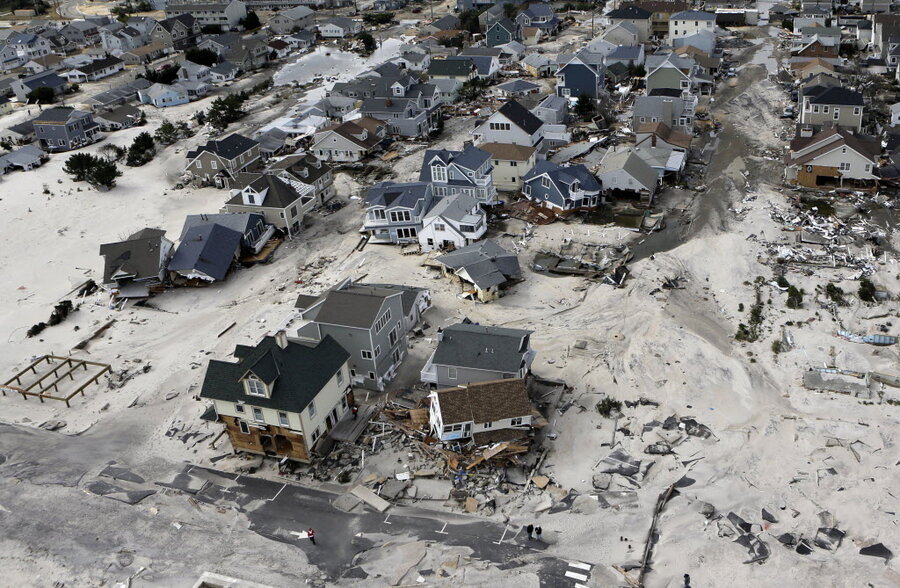New research pins some extreme weather events on climate change
Loading...
A new report plumbing 12 extreme weather events from 2012 for the degree to which human factors, especially carbon dioxide emissions, contributed to the disasters has identified anthropogenic underpinnings in some of the events, but not others.
The paper, a collaborative effort between 18 different research teams, is the latest effort to pinpoint the causes behind the storms, droughts, and warm spells that befell countries all over the world last year, in hopes of better understanding what climate trends can be expected in the future.
In recent years, how much climate change has been a factor in the hurricanes slamming into the US East Coast or the droughts parching farmland in the Midwest has been an outstanding question in climate science. Answering that question has acquired high-octane urgency, as scientists now suggest that better understanding the human origins of extreme weather could help scientists predict when, where, and how those events might impact people.
“People can actually use some of this information to make decisions,” says Thomas Peterson, principal scientist at the National Climactic Data Center and one of the lead editors on the report. For example, it makes a difference to a Midwestern farmer who has just weathered a punishing drought whether or not that experience is rare event or part of a long-term trend toward a drier climate, he said.
The report cautions against the idea that climate change causes extreme weather, suggesting that while climate change is a factor in such events, it is in none of the studied cases the sole factor. In the paper, the team likens the influence of climate change on superstorms to speeding while driving: If a crash happens, it might be because the driver was texting or because the roads were wet, but the speeding made it more likely that the crash would happen or be more catastrophic.
That in mind, climate change did not necessarily cause Hurricane Sandy, but it did contribute to its severity, the scientists said. The report, looking at just the hurricane’s flooding patterns, said that sea levels up from their 1950 values caused a storm surge that was also unusually high, plunging low-lying areas along the East coast under a barrage of water: storm tide levels broke 16 records along western Atlantic coastline.
The results also suggest that future storms, whirling in on the backs of swelled-up seas, could do increasingly catastrophic damage within longer and longer ranges.
But a peculiar event in the Netherlands, where the temperatures dropped low enough that thrilled citizens hurried to host the annual 11-cities ice skating race, only to find that the ice was not thick enough to support the deluge of skaters, was pinned not on climate change, but on a natural weather fluke: Heavier-than-unusual snowfall had served as a kind of tea cozy for the ice, preventing it from thickening, the report said.
Similarly, the drought that unfurled across the Midwest – the most extensive drought there since around 1950 – occurred regardless of humans, the teams found. In their research on that event, the scientists noted that increased greenhouse gas emissions increase surface heating, which affects the hydrological cycle. Yet in the computer models the scientists with modern greenhouse gas levels and then those predating the Industrial Revolution, the difference in greenhouse gas levels did not bear on the frequency of droughts in the region.
Still, the scientists cautioned that long-term studies, including a 2012 report from the Intergovernmental Panel on Climate Change (IPCC), suggest that the central US will experience longer and more crippling droughts if current emissions trends continue.
The scientists were also split on the causes of some events, underscoring the difficulties involved in piecing out climate change's effects on extreme weather. In one example, whether or not the rainfall that smacked the UK over the summer had anthropogenic causes was unclear, the report said, declining to make a formal statement on human contribution to that event.
Much as determining exactly how much speeding increases the odds of a car crash or worsens the damage is exceedingly complicated, teasing out just what caused what and how in an extreme weather event is a taxing and fallible exercise, the authors said, noting that the results detailed in the paper come with substantial qualifications.
“The attribution conclusions for such relatively complex events remain somewhat equivocal,” the authors write in the paper. “The results in general contained in this special issue are not necessarily the final word nor the definitive treatments on these cases.”
Another difficulty is that analyzing the origins of a particular event, especially one confined just to a swath of one state, must rely on a small number of data points, says Peterson.
“Where climate change research excels is when you’re looking at lots and lots of data points,” says Peterson. “With smaller and smaller regions, or with smaller and smaller events, it becomes much trickier.”
This is the second report from the team assessing human contributions to extreme weather. The paper is published as a supplement to the Bulletin of the American Meteorological Society.








